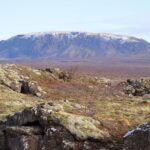After about an hour of driving and stopping here and there to marvel at nature, I arrived at the Þingvellir/Thingvellir (Parliamentary Plains) National Park. The car park was busy, but I got a spot and paid by smartphone using the QR code next to the standard park meter. There were toilets a few metres away, modern and clean.
The national park offers several walking routes. I followed the one towards Öxarárfoss (Ax River Foss), which, as visible in its name, was man-made to divert the river into the ravine. The sun shone over a clear blue sky when I followed the wooden planks that were still slippery with frost in shaded places to the waterfall. After waiting patiently for my turn, I shot some nice pictures of the scenery, trying to block out the other visitors cueing behind me with their cameras. There’s always the picture you see and those you don’t see.
I sat down to have a cup of tea from my thermos bottle, allowing myself to take it all in. The sun in the clear blue sky above me warmed my face as I listened to the constant, low thunder of the water flowing over the edge and finding its way around the rocks, forming a small river that led away from the viewing platform. People ebbed and flowed in and out, taking pictures. When I saw the next group approaching, I packed up and walked the other way through the ravine caused by tectonic plates drifting apart and up some stairs to a viewing platform. This slightly elevated position offered a view over the ravine onto a lake with some steam ascending from a geyser in the distance. I wondered what motivated the Vikings a thousand years ago to choose this place for their parliament meetings apart from its obvious beauty. They couldn’t have known that the Eurasian and the North American tectonic plates drifting apart created this ravine, literally splitting the land. Maybe it was just the feeling that this place had something special about it? I guess we’ll never know.






















